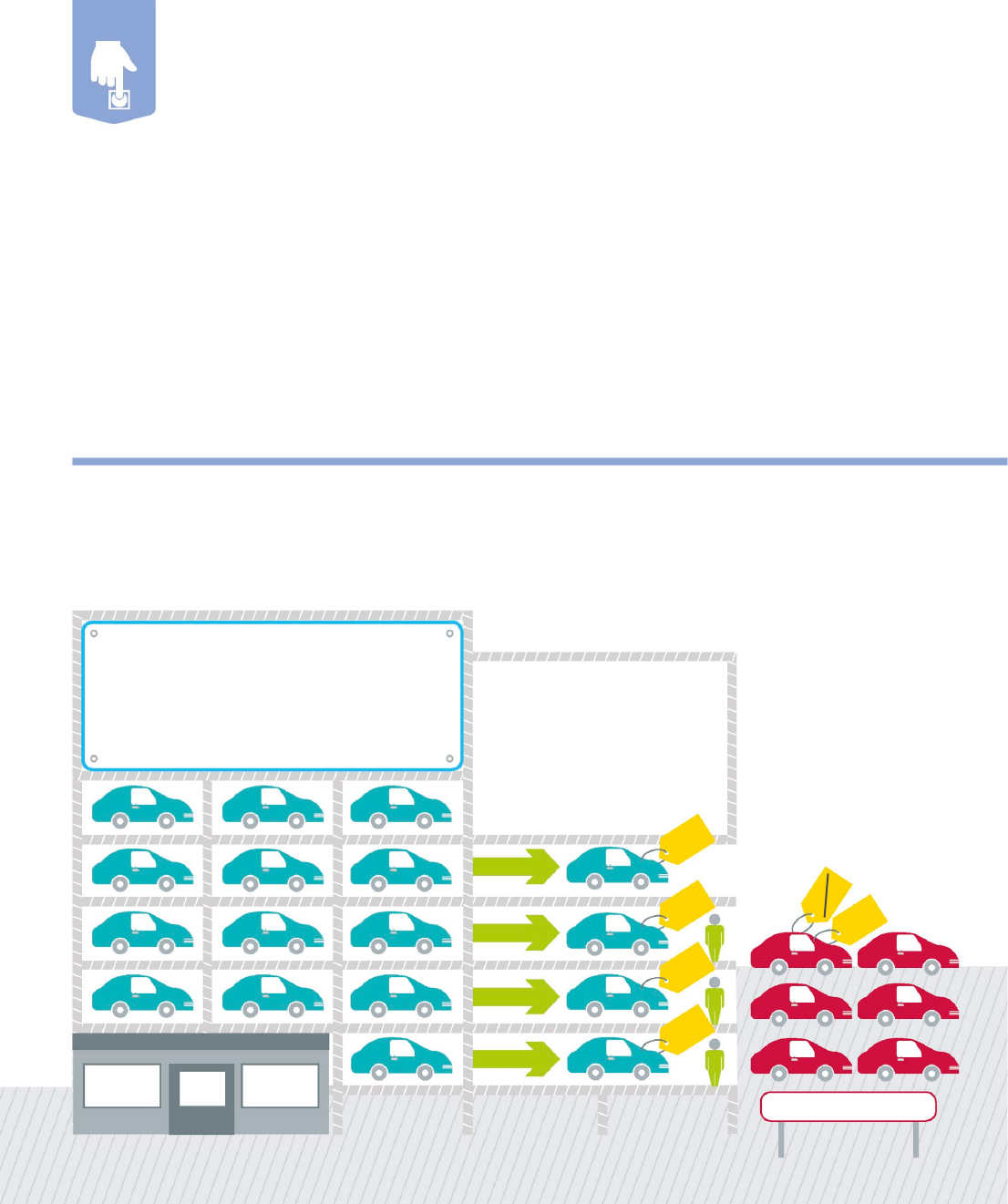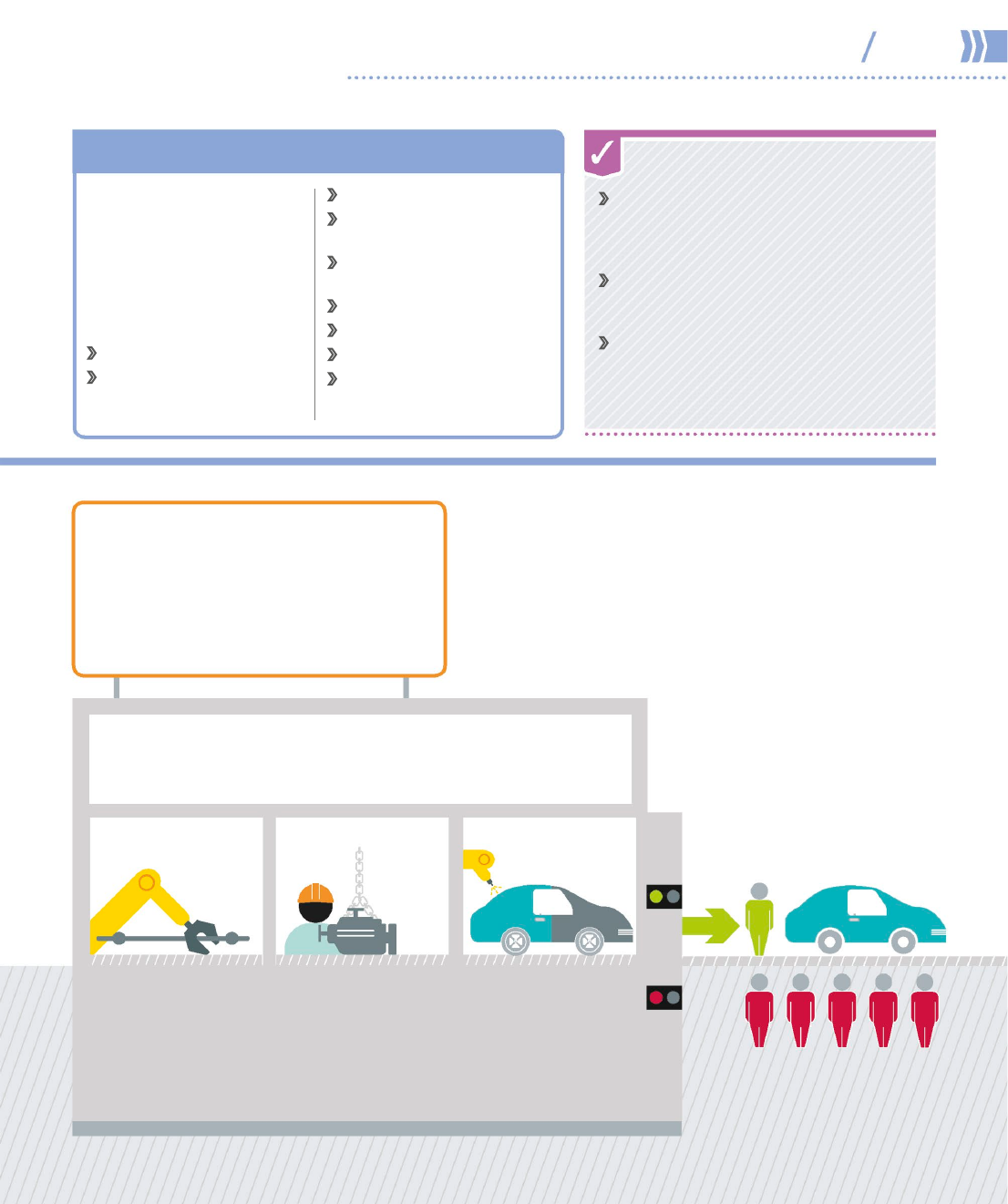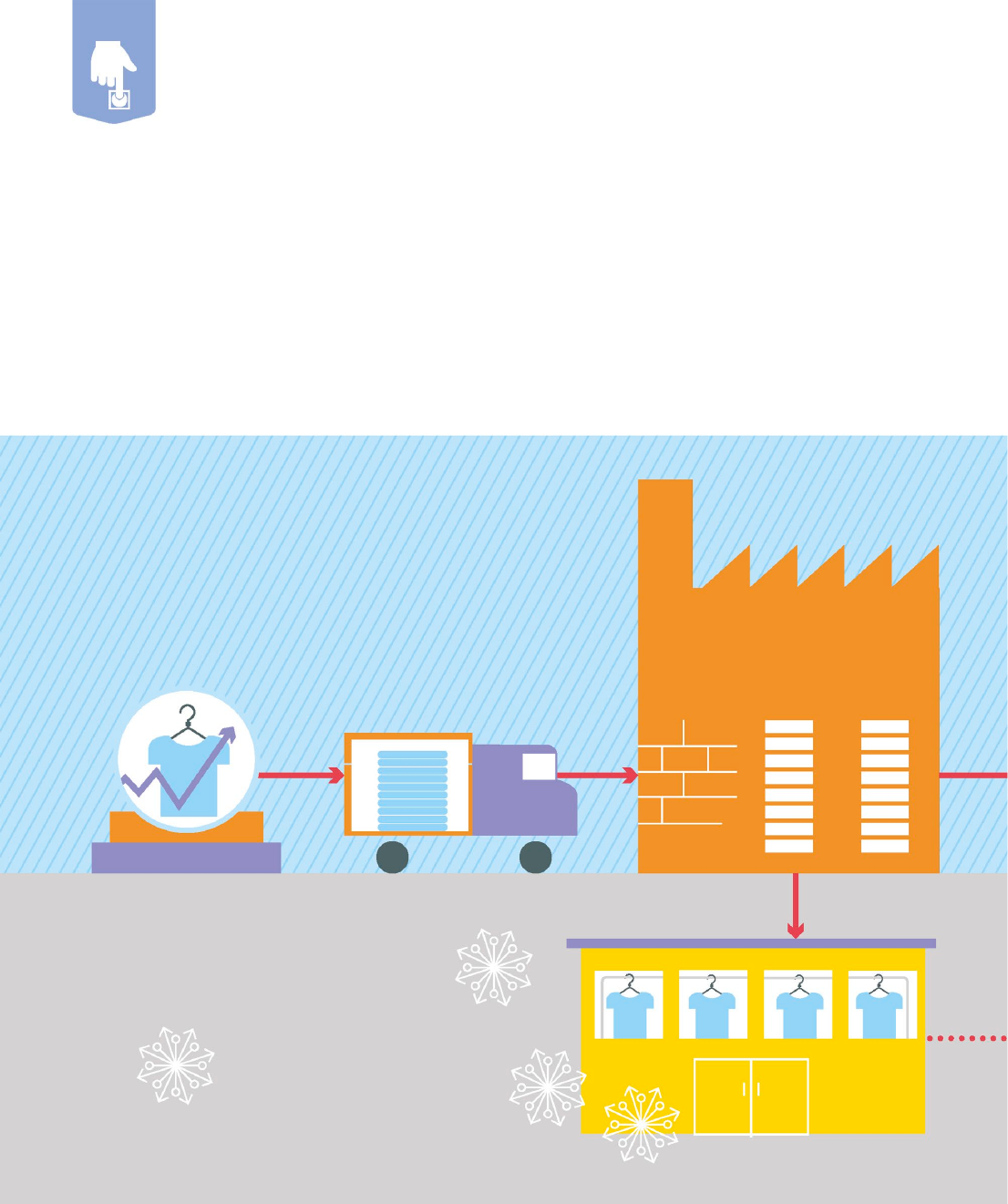
Control
Essential in any type of organization, control is fundamental when the primary
goal is to generate profits. Control needs to cover costs, resources, and quality
of the product or service to ensure that the operation runs smoothly. As well
as crossing departments, control has to run from top to bottom, with directors
formulating strategy while managers allocate resources, people, materials,
and equipment and oversee the work of individuals and teams.
The chain of control
It is simplest to think of a business as an end-to-end chain.
Leaders have to make decisions on business goals, strategy,
and policies at the start of the chain. This is critical for
control along the chain. If there is no clear direction from
the start, problems become exacerbated as they travel
Control in practice: strategic control
ABC Cake Company’s goal is to be the top-selling
cupcake business. Its directors determine the
quantity and quality of cupcakes the company
needs to sell and whether to invest in a new
factory. They also set the scale of investment and
estimate when it will begin to yield returns, and
how long it will take for the project to repay its
full cost (payback period).
Management
control
The management
team ensures that
everyone meets
their targets, talks
with other links
in the chain, and
works seamlessly
to be a top-selling
cupcake business.
FUNCTIONS ALONG
THE CHAIN
While directors work
on strategic investment,
policy, and process
control, management
may use tools such
as Six Sigma to perfect
operational control.
See pp.320–321.
abc
cakeS
Investment relies
on cash flowing
back into the
business from
the cupcake
sales, balanced
by the cost of
production.
Policies on, say,
maintaining the
optimum level of
inventory are
supported along
the chain by
finance, HR,
and IT.
Processes are
in place to
control costs,
with continual
reviews of the
most efficient use
of resources.
Procurement
purchases raw
materials from
companies
that meet its
stringent
standards.
farther along the line. Controls are put in place all the way
along the chain to ensure that the organization is working
toward its goals, that it meets the desired standards, and
that individuals and teams are clear about what is involved
in specific tasks.
US_312-313_Control_Overview.indd 312 15/12/2014 13:55
312 313
how operations and production work
Control
Task control
Metrics and key performance indicators
are set for each task. They control, for
example, how long it takes to ice and
decorate a batch of cupcakes.
Many industries are subject to
external controls as well as their own:
Financial institutions National and
international regulatory controls
Advertising industry National
regulation to protect public interest
Health and social care National
laws to protect vulnerable members
of the public
Manufacturing National
regulations on health and safety
ABC
CAKES
ABC
CAKES
Goods received
checks on-time
delivery and that
all inputs are
consistently of
the right quality.
See pp.318–319.
Stock control
uses sophisticated
systems to
ensure the
optimum level
of inventory.
See pp.316–317.
Production
has metrics for
the quantity
and quality of
the cupcakes.
See pp.314–315.
Marketing
benchmarks the
price and reviews
the promotion
of the product
against competition.
See pp.332–333.
Sales
works toward
detailed targets.
See pp.314–315.
LEGALLY IMPOSED
CONTROL
ABC CAKE COMPANY
“Drive thy business
or it will drive thee.”
Benjamin Franklin
130:1
the average ratio of CEO
to employee pay of FTSE 100
companies in 2014—compared
with a ratio of 47:1 in 1998
US_312-313_Control_Overview.indd 313 15/12/2014 13:55

312 313
how operations and production work
Control
Task control
Metrics and key performance indicators
are set for each task. They control, for
example, how long it takes to ice and
decorate a batch of cupcakes.
Many industries are subject to
external controls as well as their own:
Financial institutions National and
international regulatory controls
Advertising industry National
regulation to protect public interest
Health and social care National
laws to protect vulnerable members
of the public
Manufacturing National
regulations on health and safety
ABC
CAKES
ABC
CAKES
Goods received
checks on-time
delivery and that
all inputs are
consistently of
the right quality.
See pp.318–319.
Stock control
uses sophisticated
systems to
ensure the
optimum level
of inventory.
See pp.316–317.
Production
has metrics for
the quantity
and quality of
the cupcakes.
See pp.314–315.
Marketing
benchmarks the
price and reviews
the promotion
of the product
against competition.
See pp.332–333.
Sales
works toward
detailed targets.
See pp.314–315.
LEGALLY IMPOSED
CONTROL
ABC CAKE COMPANY
“Drive thy business
or it will drive thee.”
Benjamin Franklin
130:1
the average ratio of CEO
to employee pay of FTSE 100
companies in 2014—compared
with a ratio of 47:1 in 1998
US_312-313_Control_Overview.indd 313 15/12/2014 13:55

How it works
Every business has to consider how much capacity
it needs for its operation, and how to manage
this capacity both day-to-day and in the future.
Management has to choose a priority: whether to
deliver excellent customer service by having extra
capacity, and thus price its products or services high;
or to manage its resources efficiently for a better return
on investment, at the risk of disappointing customers
Managing capacity
if and when demand goes beyond capacity.
Businesses may offer consumers incentives to help
manage capacity—for instance, cheaper late-morning
train fares encourage passengers to travel after rush
hour, easing overcrowding on trains that are full to
capacity in the early morning. Likewise, many hotel
chains do not charge a fixed price for rooms, pricing
them according to demand to maintain capacity.
In terms of production, capacity means how much work can be
achieved in a given time. Ideally, a business matches its capacity to
customer demand, using its resources with maximum efficiency.
Capacity decisions
The fundamental decision is whether to compromise
on demand or capacity—whether to put customers or
the streamlining of operational costs first.
Customer focus
The company, in this case a car dealer, keeps
more cars in stock than required so it can
always satisfy customer demand.
$$$
$
$$$
$$$
$$$
$$$
Sale
Increase demand
To use up stock, pricing
policies increase demand
by encouraging customers
to buy fast—for example,
offering on-site deals
for older car models.
Manage capacity—
raise prices
Customers are happy to have a
product immediately but must
pay a higher price to cover the
cost of holding excess stock.
US_314-315_Managing_Capacity.indd 314 21/11/2014 16:29
314 315
HOW OPERATIONS AND PRODUCTION WORK
Control
HOW CAPACITY AFFECTS A COMPANY
Capacity management is critical
to ensure, for example, that a
manufacturing operation has
the right level of resources to
work to a production schedule.
It affects many areas of the
business, as all are interlinked
and cost the company money:
Factory or office size
What and how much
equipment is needed
Staffing levels
Use of labor—for example,
shift work
Which materials to use, how
much/how often to order
Inventory (stock) levels
Production scheduling
Speed and ease of processes
Type of information
technology used
Potential capacity The capacity that
can be made available long-term, a factor
that affects investment decisions and
business growth
Immediate capacity The maximum
potential capacity available in the
short term
Effective capacity The total capacity
that is realistically achievable when all
resources are being used optimally
NEED TO KNOW
Resource focus
The company uses resources as efficiently as
possible. Wastage is kept to a minimum, but
satisfying demand is hard because work is at
full capacity and output cannot rise.
Demand not satisfied
Company is unable to meet surges in
demand; customers may have to wait
while production catches up, and
business may be lost to competitors.
Manage capacity—keep stock low
It produces stock according to demand and holds low
inventory to minimize unnecessary spending and storage costs.
90 million
the number of iPhone 6 units
made by one manufacturer
to meet demand in 2014
US_314-315_Managing_Capacity.indd 315 21/11/2014 16:29

314 315
HOW OPERATIONS AND PRODUCTION WORK
Control
HOW CAPACITY AFFECTS A COMPANY
Capacity management is critical
to ensure, for example, that a
manufacturing operation has
the right level of resources to
work to a production schedule.
It affects many areas of the
business, as all are interlinked
and cost the company money:
Factory or office size
What and how much
equipment is needed
Staffing levels
Use of labor—for example,
shift work
Which materials to use, how
much/how often to order
Inventory (stock) levels
Production scheduling
Speed and ease of processes
Type of information
technology used
Potential capacity The capacity that
can be made available long-term, a factor
that affects investment decisions and
business growth
Immediate capacity The maximum
potential capacity available in the
short term
Effective capacity The total capacity
that is realistically achievable when all
resources are being used optimally
NEED TO KNOW
Resource focus
The company uses resources as efficiently as
possible. Wastage is kept to a minimum, but
satisfying demand is hard because work is at
full capacity and output cannot rise.
Demand not satisfied
Company is unable to meet surges in
demand; customers may have to wait
while production catches up, and
business may be lost to competitors.
Manage capacity—keep stock low
It produces stock according to demand and holds low
inventory to minimize unnecessary spending and storage costs.
90 million
the number of iPhone 6 units
made by one manufacturer
to meet demand in 2014
US_314-315_Managing_Capacity.indd 315 21/11/2014 16:29

How it works
Stock may include finished goods, work in progress,
and raw materials. Getting the right level is a balance
between having enough to meet customer demand and
having too much, which is costly in terms of finished
goods, storage space, and warehouse staff. Stock may
also lose value if it perishes or become unsalable
because of changes in fashion or obsolete technology.
Inventory
Effective inventory management involves systems
and programs for sales forecasts, production
targets, and actual inventory status, plus the
physical tracking and handling of the different
items. Bar codes and radio-frequency identification
(RFID) tags have revolutionized inventory management,
making it much easier to monitor stock levels.
Inventory management
Successful inventory management is a fine balance between satisfied
customers and minimizing the risk of holding too much stock. In this
example, the clothing company is managing the supply of T-shirts for a
range of sites and for direct delivery to customers.
Companies have to manage inventory (stock) to meet customer
demand, even if they trade online and have no physical storefront.
Successful inventory management is a complex process.
Order from suppliers
Decisions on the level of raw
materials to hold are based on lead
times and reliability of suppliers.
Production
The quality of raw materials and
finished goods is checked at every
stage of production.
Smaller storage
Firm may use smaller facilities to hold
buffer stock—for example, to meet
seasonal demand.
Make sales forecasts
The company sets production
targets based on prediction of
demand.
US_316-317_Inventory.indd 316 21/11/2014 16:29
316 317
How operations and production work
Control
First in, first out (FIFO) Oldest inventory items
sold first (or recorded as sold for accounting
purposes rather than physically moving goods)
Last in, first out (LIFO) Most recently produced
items sold first (or recorded as sold)
Stock-keeping unit (SKU) A distinct item that
has its own stock code
RFID tag A chip that enables remote tracking
of an item by radio sensors
NEED TO KNOW
142,000
different items were
handled by Walmart
Supercenters in any
one store in 2005
Main warehouse
Company may have one main warehouse or a number
of warehouses as hubs for smaller storage facilities.
Delivery to customers
Efficient and timely delivery is part of
the overall customer experience,
especially as online shopping grows.
Stock is checked in by scanning bar
codes or RFID tags.
Customer returns
Returns are checked out by scanning
bar codes or RFID tags. Batch number
and other data can be monitored.
US_316-317_Inventory.indd 317 21/11/2014 16:29
..................Content has been hidden....................
You can't read the all page of ebook, please click here login for view all page.
